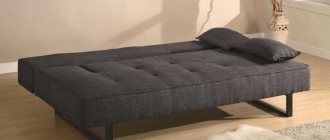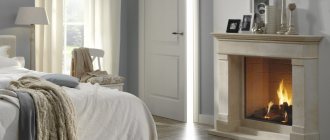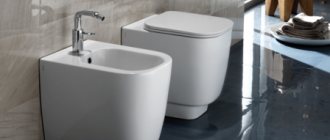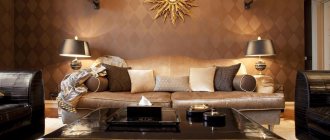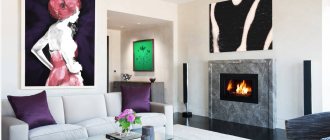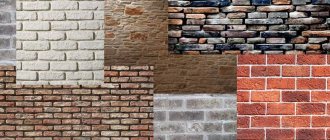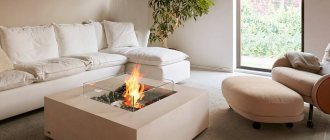Sofa and ottoman - oriental guests in a European interior
Both the sofa and the ottoman are atypical items for European interiors.
The first was brought to the Old World from the Ottoman Empire, the second comes from Persia. These sofas are united not only by their oriental origin, but also by their purpose - complete rest during the daytime. What is the difference between them?
In the classic version a sofa is a wide sofa whose backs and armrests are the same height. In a modern, Europeanized version, the armrests of the sofa may be lower than the backrest or even absent.
In the photo: Arketipo Coast sofa.
In the photo: Meridiani Scott folding sofa.
In the photo: the laconic sofa-sofa Alberta Recanati is made with two options for armrests.
In the photo: a sofa in the classic style Mantellassi Elisir.
But an ottoman in the traditional sense is a wide, low sofa without a back. However, in a modern interpretation, it can have a low back and the same armrests on one or both sides.
Thus, distinguishing between these types of living room sofas is sometimes difficult.
In the photo: Minotti Klimt ottoman.
Pictured: modern ottoman with backrest Bonaldo Pierrot.
In the photo: Lago Air is a modern version of an ottoman.
In the photo: modular ottoman Patmos from the Riva 1920 factory.
In the photo: designer ottoman Tonin Casa Duny 7380.
How to put
There are four possible ways to place a sofa next to a window:
- Close to the windowsill with the backrest.
- The sofa has its back to the window and at a distance from it.
- To the opening with the front part.
- Lateral position.
A sofa along the window with its back close will be the simplest solution. So it can even stand in a small room in a Khrushchev-era apartment. The recreation area with it will be sufficiently illuminated, it will always be pleasant to sit on it, read, or gather in company. But the main problem is the radiator.
It will be covered with furniture, making the heating itself ineffective. Of course, this can be solved if the radiator is removed from the window sill area. However, then it will take up space along the other wall, not the fact that this is better. Therefore, this option is suitable only when there is no battery in the location area.
If you plan to not only sit on it, but also sleep, there will be another problem - drafts. It all depends on the person. Some tolerate them well and can only sleep with the windows open. But for others it will be unpleasant. Be that as it may, the combination of a hot radiator next to you and cold air from the window is not conducive to sleep. The best solution would be to use this position if the house is heated by underfloor heating or heated air from a ventilation system.
This is interesting: now the interior of apartments often includes soft window sills, when a soft mattress is installed on the window sill itself and the backrest is decorated with pillows on the window. How safe such a technical solution is is still unknown, but here even the radiator will not interfere, since it is located below.
The location with the back to the window and at a distance from it is devoid of almost all the disadvantages of the previous case. Direct drafts from the window are practically eliminated, the radiator is open and freely heats the room. You can hang large beautiful curtains all the way to the floor.
And it will take up a lot of useful space - the space between the back and the window will only be occupied by small shelves, tables, chests of drawers and shelves no higher than the back. This area can be used to place a desk, if necessary, or a desk for a child.
The main disadvantage of this method is that large furniture located in such a way not only gets in the way, but also does not correspond to its purpose. The seating area with your back to the window will be dark and uncomfortable. The dining area in this location will be comfortable, but not too interesting.
Most people prefer to look out the window onto the street at lunch or tea, rather than sit with their backs to it. Only a small couch by the window can stand like this, but not a full-fledged sofa with a backrest.
Positioning the seats towards the window is more interesting. Especially if the house has panoramic windows, a French balcony with large glass doors. You can sit on the sofa and admire the view of the street, yard, watch your children or neighbors, watch your own car parked under the windows, admire the garden or your own pond near a private house.
True, if the window has a sill, only the sky will be visible, but sometimes this is quite enough for a good mood.
A folding sofa-book or pull-out also looks good when placed with the seats facing the window.
The main thing is that there should be some free space between them and the window when unfolded, then it will be convenient to lay them out and assemble them. At the same time, this approach for a small-sized apartment will allow you to allocate space for a room with furniture for a dining area, when a small movable table is placed in front of the seat, and you can already sit down to eat. At the same time, the kitchen will be unloaded and more free.
It’s good if there is a French-type balcony with transparent lattice fencing. It makes sense to place a sofa opposite it and access the balcony in the form of wide glazed doors, removing the window sill area. However, demolition will require a permit.
The side position is the most universal; the seat facing the window sideways gives the greatest scope to the designer’s imagination.
Has the following advantages:
- The radiator area at the window sill remains open.
- You can use floor-length curtains.
- You can place two sofas opposite each other, creating a relaxation area for the group.
- These two can be placed with their backs facing each other, and the people sitting on them will not interfere with each other.
- The place near the window will be well lit, and the person sitting will have enough light.
- The sofa by the window can be freely folded out and forms a sleeping place, if there is enough space for this.
- Opposite it you can easily put a table and create a dining area.
Often this space near the window is adjacent to one of the side walls. Thus, you can place a sofa by the window in the living room sideways, including a furniture corner, and you will get a classic room design with furniture against the wall, familiar to Soviet apartments. You can even use a built-in sofa that folds out of the closet. Any designs and sizes can be arranged in this way.
In this case, the only thing that needs to be taken into account for asymmetrical furniture is how the sofa will be positioned by the window, on the right or left. The corner can be placed so that its short side runs along the window, or vice versa, so that one of its sides is opposite the window. At the same time, inside the room with a corner sofa, a space will be created that is partially fenced off from the rest and is quite bright.
A corner sofa by the window in the interior looks very stylish; you can find many photos where it is found both in the living room and by the window in the bedroom, the design of which is quite professional.
The couch is an aristocrat among sofas
The sofa-couch came into fashion under Louis XV. Initially, the couch looked like a couch with eight legs and did not have a headboard. Later, its shape changed - a back appeared, and half of the legs disappeared.
In a private interior, a couch is a piece for sitting in a relaxed position, slightly diagonally and not fully extending your legs.
In the photo: a couch with textile trim Arketipo Coast.
Pictured: FlexForm Dragonfly daybed.
There is a separate type of couch - recamier. It is easy to recognize by its specially shaped high armrest, which merges with the back at the end. You can sit on the river reclining on your side - in this case, its shape follows the curves of the body.
In the photo: recamier from the Silik factory. Left: Art. 599. Right: Art. 598.
How the couch is used today
In modern terms, a couch is a compact sofa designed to seat one person. There are several options for the described furniture item, which are intended for different purposes:
- for the hallway - here you can sit down to take off your shoes or wait for one of the family members to get dressed;
- for the living room or bedroom it serves as a “bed” where it is convenient to relax, read your favorite book, magazine or watch TV;
- an office sofa is a good idea to have an informal meeting with your companions over a cup of coffee or lie down to relax at lunchtime;
- for the nursery - a cozy place to look after the baby and read a bedtime story until he falls asleep.
The couches offered by furniture manufacturers are made of different materials and differ in design, size and functionality. In general, we are talking about compact, cute sofas that are suitable even for rooms with limited space.
They also produce transforming couches equipped with a folding mechanism. With one movement of the hand they turn into a bed. If guests often stay late at home, this type of furniture will always help out. Guests can be comfortably accommodated for the night without disturbing the hosts.
Is a chaise longue the same as a couch?
No. Unlike a couch, it is customary not to lie on a chaise longue, but to sit, leaning only slightly on the armrest.
Kozette literally translates as causette - “light conversation”, which fully corresponds to the purpose of this item. How to recognize her? A chaise longue is a cross between a sofa and a banquette. The first one has a backrest, the banquette does not, and the chaise longue has it in a “shortened” form.
In the classic version, the chaise longue is divided in two by a recess in the back. This can be explained historically - this piece of furniture was created as a private sofa for two. On it, lovers could talk, while their small distance from each other was emphasized.
In the photo: the classic Volpi Capri chaise longue.
In the photo: designer chaise longues from Christopher Guy: 60-0243 and 60-0001.
Sections, positions, cover of the couch
Typically, a standard cosmetology couch has 2-3 sections. However, the greatest convenience can be provided by a product with 4 sections. Each section can change its position. The patient does not need to do anything on his own - the position of the sections is determined by the settings. With the help of a drive it is easy to do this kind of work. When choosing a couch, it is important to pay attention to the covering and filling. Patient comfort depends on the type of filler. It is better to take models in which the upholstery filler has a shape memory function. It guarantees excellent support and completely eliminates the formation of bedsores and symptoms of muscle compression. When choosing upholstery, you should pay attention to whether the material can withstand disinfection. Modern materials cope well with such influences.
